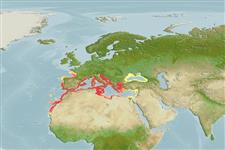Issue
Placement in Sparidae from Centracanthidae from Santini et al. (2014:Ref. 95347). Suggestion already made in Garrido-Ramos et al. 1995;
Hanel & Sturmbauer 2000; Summerer et al. 2001;
Orrell et al. 2002; Orrell & Carpenter 2004; Chiba
et al. 2009; Hanel & Tsigenopoulos 2011.
Environment: milieu / climate zone / depth range / distribution range
Ecología
marino; rango de profundidad 15 - 328 m (Ref. 56504). Subtropical; 47°N - 20°N, 19°W - 42°E
Eastern Atlantic: entire Mediterranean, the Black Sea, southern Sea of Azov, and Atlantic coasts from Portugal to Morocco, including the Canary Islands and Madeira (Ref. 7349).
Length at first maturity / Tamaño / Peso / Age
Maturity: Lm 9.1 range ? - ? cm
Max length : 24.2 cm TL macho / no sexado; (Ref. 86700); common length : 14.0 cm TL macho / no sexado; (Ref. 3397); peso máximo publicado: 55.00 g (Ref. 86713)
Short description
Claves de identificación | Morfología | Morfometría
This species is distinguished by the following characters: protractile premaxilla; head length equals and longer than body depth; lateral line scales 75 or more; a black spot on the body side above the pectoral fin; body gray above and silvery below; color varies with age, sex and season (Ref. 124120).
Depth range from 15-170 m but up to depth of 328 m in the eastern Ionian Sea (Ref. 56504). Inhabit Posidonia beds and muddy bottoms. Occur in schools except during breeding (Ref. 7081).
Life cycle and mating behavior
Madurez | Reproducción | Puesta | Huevos | Fecundidad | Larva
Spawns on detritic sandy bottoms, where the nests are excavated. A brightly colored male actively guards each nest, while females and some males swim above the area. At the end of the incubation period, the males lose their coloration, group into large schools and move to feeding places (Ref. 7081). Also Ref. 103751.
Heemstra, P.C., 1990. Centracanthidae. p. 768-772. In J.C. Quero, J.C. Hureau, C. Karrer, A. Post and L. Saldanha (eds.) Check-list of the fishes of the eastern tropical Atlantic (CLOFETA). JNICT, Lisbon; SEI, Paris; and UNESCO, Paris. Vol. 2. (Ref. 7349)
IUCN Red List Status (Ref. 130435: Version 2024-2)
Threat to humans
Harmless
Human uses
Pesquerías: escaso valor comercial; pesca deportiva: si
Herramientas
Special reports
Download XML
Fuentes de Internet
Estimates based on models
Preferred temperature (Ref.
123201): 11.8 - 17.8, mean 14.4 °C (based on 162 cells).
Phylogenetic diversity index (Ref.
82804): PD
50 = 0.5039 [Uniqueness, from 0.5 = low to 2.0 = high].
Bayesian length-weight: a=0.01096 (0.00977 - 0.01231), b=3.01 (2.98 - 3.04), in cm total length, based on LWR estimates for this species (Ref.
93245).
Nivel trófico (Ref.
69278): 3.0 ±0.0 se; based on diet studies.
Generation time: 2.5 (1.3 - 4.7) years. Estimated as median ln(3)/K based on 17
growth studies.
Resiliencia (Ref.
120179): Medio, población duplicada en un tiempo mínimo de 1.4-4.4 años (K=0.15-3.07(?); tmax=7).
Prior r = 0.59, 95% CL = 0.39 - 0.89, Based on 2 full stock assessments.
Fishing Vulnerability (Ref.
59153): Moderate vulnerability (40 of 100).
Nutrients (Ref.
124155): Calcium = 115 [57, 226] mg/100g; Iron = 0.677 [0.204, 3.677] mg/100g; Protein = 19.1 [17.2, 21.2] %; Omega3 = 0.664 [0.321, 1.550] g/100g; Selenium = 20.3 [9.3, 40.8] μg/100g; VitaminA = 35.4 [10.3, 121.8] μg/100g; Zinc = 0.505 [0.198, 1.909] mg/100g (wet weight); based on
nutrient studies.
